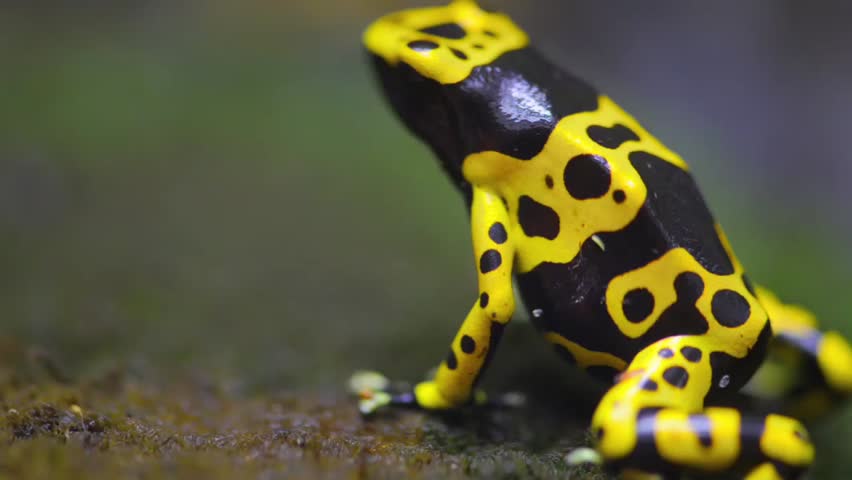ANIMAL: Yellow-Banded Poison Dart Frog Dendrobates leucomelas Type of Animal: Frog Habitat: Areas in tropical rainforest/seasonal forest/dry forest close to freshwater Location(s): Extreme E Colombia, S & NE Venezuela, NW Guyana, & parts of Brazil nearby Appearance: Bright yellow or orange w/ black broad stripes and/or spots, females slightly bigger than males, also called Bumblebee Poison Frog. Food/Diet: Beetles, ants, termites, crickets, spiders, tadpoles/froglets (including of own species), giant damselfly nymphs, & fruit flies. Tadpoles sometimes eat algae as well. Status in Wild: Stable Conservation: Breeding in zoos, aquariums, & herpetoculture. Lifestyle: Usually found in small groups of around 5 frogs Additional Info: Called: Male Female Young-Tadpole Group-Army Weight: Male-0.10 oz Female-0.11 oz Gestation: 2 weeks Life Span: 5-7 years in wild, 10-15 years in captivity Body Length: Male-1.57 in Female-1.6 in Due to skin toxins, only some snakes eat adults. Tadpoles/froglets eaten by larger poison dart frogs, each other, damselfly nymphs, & mayfly nymphs. During breeding season, males chirp, buzz, trill, & hum to attract females. Females lay 2-13 eggs per clutch, sometimes up to 1,000 in a breeding season. Breeding usually occurs in rainiest periods of the year. Males (& sometimes females) care for eggs & newly hatched tadpoles, transporting them to small pools. Tadpoles turn to froglets at around 3 months & become adults at 1-1.5 years. Possibly declining due to over-collection for pet trade, habitat destruction, & exploitation. Glandular, adhesive pads on toes help in climbing and positioning. They estivate during drier periods. Only poison dart frog known to do this. They’re active during the day (diurnal). Has one of the loudest calls among poison dart frogs sounding like a bird trill. Males use trills, chirps, buzzes, & hums. Tadpoles use vibrations in water to signal presence to parents. Very hard to tell sexes apart. Calling most intense an hour or 2 after sunrise & before sunset. Fun Fact(s): Used in medical research due to skin toxins being possible source of medicine. Their bright colors serve as warning to most potential predators. Hunters use skin toxins on darts & arrows. While toxic in wild, they lose much/all of toxicity in captivity due to diet. In captivity, they’re only fed nontoxic prey items, like crickets & fruit flies. In wild, they eat lots of ants, termites, & toxic beetles.

Daniel, this is great! My nephew and I are having fun reading interesting facts from your blog. Loving the group names! Congrats on publishing this great website.
Good to hear from you! Thanks for your feedback!